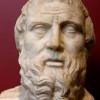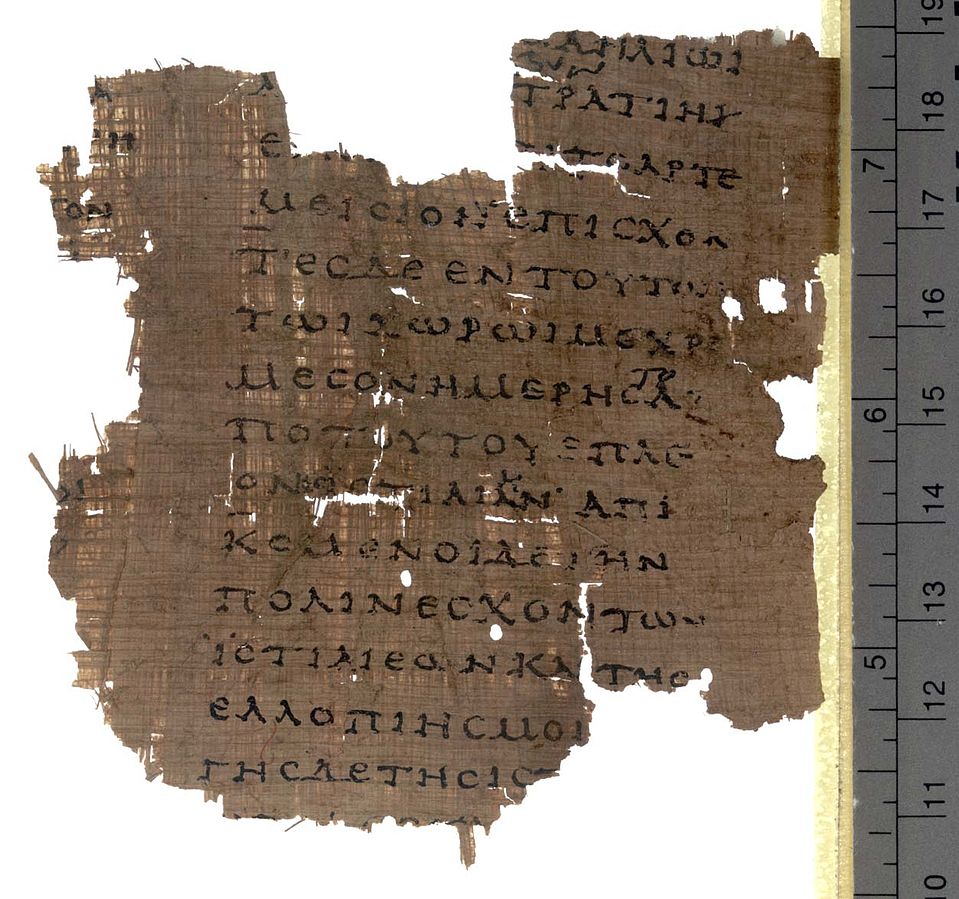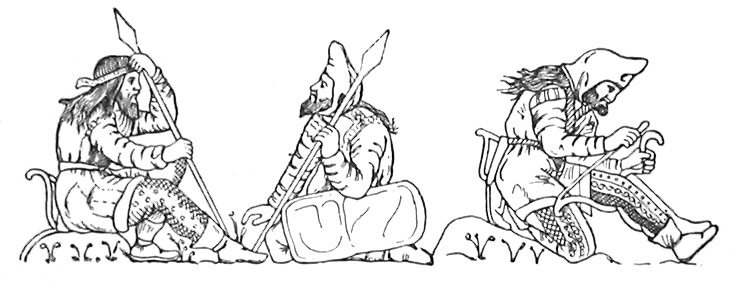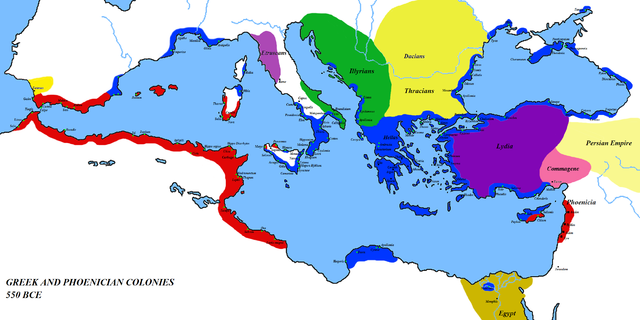
Ancient Greek Herodotus
or Researching Ancient History while Playing the Glass Bead Game with Pythagoras Art, Symbols and Signs, Spirituality, defaultAncient Greek Herodotus Ἡρόδοτος 484 BC – 425 BC, the Father of History
A Barberian about Slavs and Ancient Europe, Balkan
by Nataša Pantović
History as Playing the Glass Bead Game with Pythagoras
In 1943, the Nobel wining novelist Herman Hesse published his novel The Glass Bead Game, Das Glasperlenspiel, set in a monastic society that develops minds by studying and playing the glass bead game. One would master philosophy and literature, and then focus on mathematics and music to be able to play the Game. Both mathematics and music are with us since the time of Pythagoras. History is like playing the Hesse's glass bead game with Pythagoras...
Mathematics is described as the science of pattern and music as the art of pattern, both using meditation within the process of contemplation developing own language of symbols.
The Ancient Greek Herodotus Ἡρόδοτος 484 BC – 425 BC (H-R-DATOS) as his name suggests was a King's historian, the one who collects data for the King or the Priest. It is hard to believe that a family would have given such a name to a child. (“Statistcians” you shall be, so we shall name you H-R-DaToS).

Fragment from the Herodotus Histories Papyrus 200 AC
Aristotle refers to a version of The Histories written by "Herodotus of Thurium," and some passages in the Histories have been interpreted as proof that he wrote about southern Italy from his personal experience there. Of course, researching life and work of a person who has lived 2,500 years ago, everything about him or his work, but his writings, is a guess work used often in history to manipulate our minds to like or dislike a Ruler or a Nation, or a Political Party.
The earliest Greek prose to have survived intact
H-R-DaToS, a name given so a person would have beeen instantly recognized as a Scrib in the Ancient European countries, or within the Mediterranean region, or in Greece, or in Egypt, wherever his research took him. He has left a significant amount of work about his travels to the East, Africa and Egypt and he refers to Atum (aXuM, aXuN, aTHuM) as Zeus.
H-R+Datos, who might have been called Dušan or Alexander (both Slav names), was a Barbarian, the son of Lyxes and Dryo, and the brother of Theodorus was born in Ancient Balkan.
His work is the earliest Greek prose to have survived intact. He argues for continental asymmetry as opposed to the older theory of a perfectly circular earth, he also speaks of Danube and Nile. Herodotus wrote his Histories in the Ionian dialect, this rings a bell as: Macedonia, Egypt, west of Rome Byzantine Empire. 454 BC his accounts talk about traveling to Tyre and to Babylon.
According to the Suda, he was buried in Macedonian Pella. Check also Esoteric teachings of Golden Citizens of Ancient Greece
Herodotos did not work from a purely Hellenic standpoint; he was accused by the patriotic but somewhat imperceptive Plutarch of being philobarbaros, a pro-barbarian or pro-foreigner.
"This is the publication of the research of Herodotus of Halicarnassus, so that the actions of people shall not fade with time, so that the great and admirable achievements of both Greeks and barbarians shall not go unrenowned, and, among other things, to set forth the reasons why they waged war on each other."
Fragment from the Herodotus Histories Papyrus 200 AC
Scythia, Σκυθία region or Balkans

Scythian Warriors Kurgan Burial, found near Kerch Hermitage, Museum Saint Petersburg 450 BC
One of the most famous descriptions of the region is found in Herodotus in the 454 BC, who identified it as "Scythia" the region starting north of the Danube delta. He also described Gelonus, located in Scythia, Σκυθία region, today's Balkan, surrounded by the Danube at the north and the Black Sea at the east, as a city thousands of times larger than Troy; this was widely disbelieved until it was rediscovered in 1975.
According to the recognized history, by the end of the 100 AC, “Roman" governance was established over the entire Balkan Peninsula. Yet we know that “Roman” means many things... Byzantine emperor Nicephorus abolished paganism in favor of Eastern Orthodox Christianity as late as 864 AC. The Romans, with reforms of Diocletian and Constantine the Great, were so afraid of the region that they called the province "Moesia Inferior", the Inferior Moesia, with "Lesser Scythia" or Mikra Skythia (haha).
The province originally called "Scythia", was governing itself as the Byzantine Empire, until it was annexed by the Bulgars into Bulgaria that formed the first Slavic country.
The common language, is today, a Slavic language, spoken in Bulgaria, Macedonia, Serbia, Montenegro, Croatia, Slovenia, Bosnia, Montenegro, yet being a Slav or Shlav in the last 2,000 years Europe meant “being a slave” under the Ventian forces, under Germanic forces and under the Ottomans' Empire from 1389 - 1800.
The first historical Slavic state, founded by Samo in the early 600 AC, followed by the Bulgarian Empire in 681. By the 9th century, the states of Obotrites, Great Moravia, Carantania, Pannonia, Croatia, Serbia had emerged. The Diocese of Thrace (Latin: Dioecesis Thraciae, Greek: Διοίκησις Θράκης) incorporated the provinces of the eastern Balkan Peninsula (territories iof south-eastern Romania, central and eastern Bulgaria, Macedonia, and Greek and Turkish Thrace).
The South Slavs consolidated also the Grand Principality of Serbia. The Kingdom of Croatia was established between the Kupa, the Una and Adriatic Seas, without Istria and major Dalmatian coastal centers. Banate of Bosnia emerged from the 10th century by merging localities called župas.
Ancient Europe or Ancient Balkans
The Balkans have been inhabited since the Paleolithic , and the Neolithic entered Europe through the Balkan peninsula. The Bronze and Iron Ages were fully developed following the Danube river by the sophisticate city states and within the Mediterranean region by Ancient Greeks, who controlled the eastern part of the Mediterranean.
The comparison of genetic distances among the different Aromun groups and their surrounding neighbors,
when using mtDNA sequences, revealed great genetic homogeneity in the Balkan peninsula and in particular no significant differences (P < 0.05) among Greeks, Italians, Romanians and Bulgarians or Macedonians, read Slavs of the region, including Serbs, Croats, B-H, Montenegro, Slovenia.
Balkan populations have been shown to be genetically homogeneous.
The modern DNA analyses of Slavs from Poland, or the Czech Republic trace back the story to Slavs of Balkan States...
Massive population spread or demographic replacement has probably been a rarity in human history...
The 6th-century historia. Procopius, who was in contact with Slavic mercenaries is the oldest found description of the Slavs "are all exceptionally tall and stalwart men, while their bodies and hair are neither very fair or very blonde, nor indeed do they incline entirely to the dark type, but they are slightly ruddy in color..."
He claims that they live under a democracy, "For these nations, the Sclaveni and the Antes, are not governed by one man, but from ancient times have lived in democracy, and consequently everything which involves their welfare, whether for good or for ill, is referred to the people".
The 6th-century Strategikon of Maurice is considered an eyewitness of the Slavs and recommended the Roman generals to use any possible means to prevent the Sclaveni from uniting "under one ruler" and added that "the Sclaveni and Antes were both independent, absolutely refused to be enslaved or governed, least of all in their own land".
According to the Strategikon (XI.4.I-45), the Slavs were a hospitable people and did not keep prisoners indefinitely "but lay down a certain period after which they can decide for themselves if they want to return to their former homelands after paying a ransom, or to stay among the Slavs as free men and friends".
Herodotus in the 454 BC, about "Scythia"

The Mediterranean in 6th century BC Phoenician settlements are labelled in red Greek areas in blue

Serpents column of Istanbul in the centre of the Hippodrome, from Ancient Greek Delphi 500 BC
Now what was to be a Slav in Europe all through the history of Balkans?
The Venetian legal documents from 12th to 15th century tell us all about inequalities a Slav would encounter in their costal city states, now on the Croatian Adriatic Sea in Zadar, or Split.
- Michaelus Sclavus who in 1173 was involved in a trading partnership with an Italian, a certain slave named Bratemira, of Slavic origin, was sold to the Bishop of Chioggie in 1199
- A slave named Dobramir, who in 1125 was freed by a wealthy Venetian named Peter and given a liberation gift of five pounds of gold.
- In 1250 the inquisitor Rainer Sacchoni listed as heretical the sixteen Cathar Churches, including a Church of Sclavonia (Slavs).
- In 1421 Venetian authorities noted that many Dalmatians and other similar Slavs from regions of Slavonia were being transported to slave markets in Apulia.
- Legalizing in 1273 that a girl from Zadar could marry a Slav (Sclavus) only if she brought no landed dowry with her and had approval from a series of Venetian authorities, and she was banned from inheriting property from her Zadar father.
- In 1424, the Venetian government ordered its rector in Zadar to forbid the local aristocracy from having “Slavic” wives or concubines. In 1428 the rector was ordered to dismiss all “Slavs” from the Zadar garrison.
- In 1486, Venice praised the Knez (mayor) of Split for obeying orders to rid his local forces of Slavs.
- In 1413 Venice decreed the firing of any member of garrison who was married to a Slav unless the soldiers divorced them
- In 1480 Venice established a role of a town captain for its Dalmatian towns, his main task being keeping track of outsiders entering the town.
- Dubrovnik, a Croatian Independent Kingdom Town, was a rich and prosperous Kingdom of traders. In his Phd research, Dr Vujić tells us of a couple of interesting points that defined the area. The pilgrims of the time used to travel through the Croatian Coast, following their routes through the Adriatic coast. The city Councils could defend themselves only by following some wise decisions, paying ransom to the various Kings of the area. As the Papal Kingdom Protect oral, they followed the flow of the Papal decisions .
- The Church was against all the Catholic slaves' trading, but has allowed the trade of Bosnian slaves, especially the trade of Bosnian “Patarene”, or “Bogumils”, and this trend has marked the 13th and 14th century Europe. Bosnians were exported as slaves, mostly women, but also the peasants. The slaves were legally exported into many ports of Mediterranean - Venice, or Barri in Italy, in to Palestine, Crete, Marseilles, or to the other major Spanish ports. The major piracy of the time was “Slave” related, using pure force when trading. You can just imagine the dynamics, the foreign paid armies, professional tradesmen, noble men pursuing their path of Justice, all became an official channel of this amazing “export”against the Slavs whose religion (Bosnians practicing Bogumil, heretic Slavs, Shizmatic Slavs) was at the time legally punishable by burning.
Did you know that Ancient Greek philosophers (700 BC) used numbers instead of set of musical notes, in the form of strings of mathematical symbols expressing philosophical concepts. Creating a language of symbols, our ancestors related to Gods. A mathematical statement would, for example, express God as omnipotent and omnipresent, a spiral and its indefinite Pi, or an astronomical configuration or a planet governing the heavens, or a text from the Ancient Egyptian Mass, 2,500 BC, contemplating relationships between sounds, frequencies,consciousness, Gods, numbers, music.
One that is not a number but an entity (a mathematics concept of monotheism with us many thousands of years as a symbol, a drawing, or a sound), materializes as two that is a female force going forth sealing expression, becoming a trinity of forces, Tao manifesting within four elements on Earth as sounds, symbols, frequency that finalize its journey as 10. That in practical terms becomes 7 (A to G in music, Do-Si) moved to a different state of consciousness by the 8th, that is not a number but an entity, A or Do repeated on a different level.






Ancient Greek Herodotus No comments on Ancient Greek Herodotus: